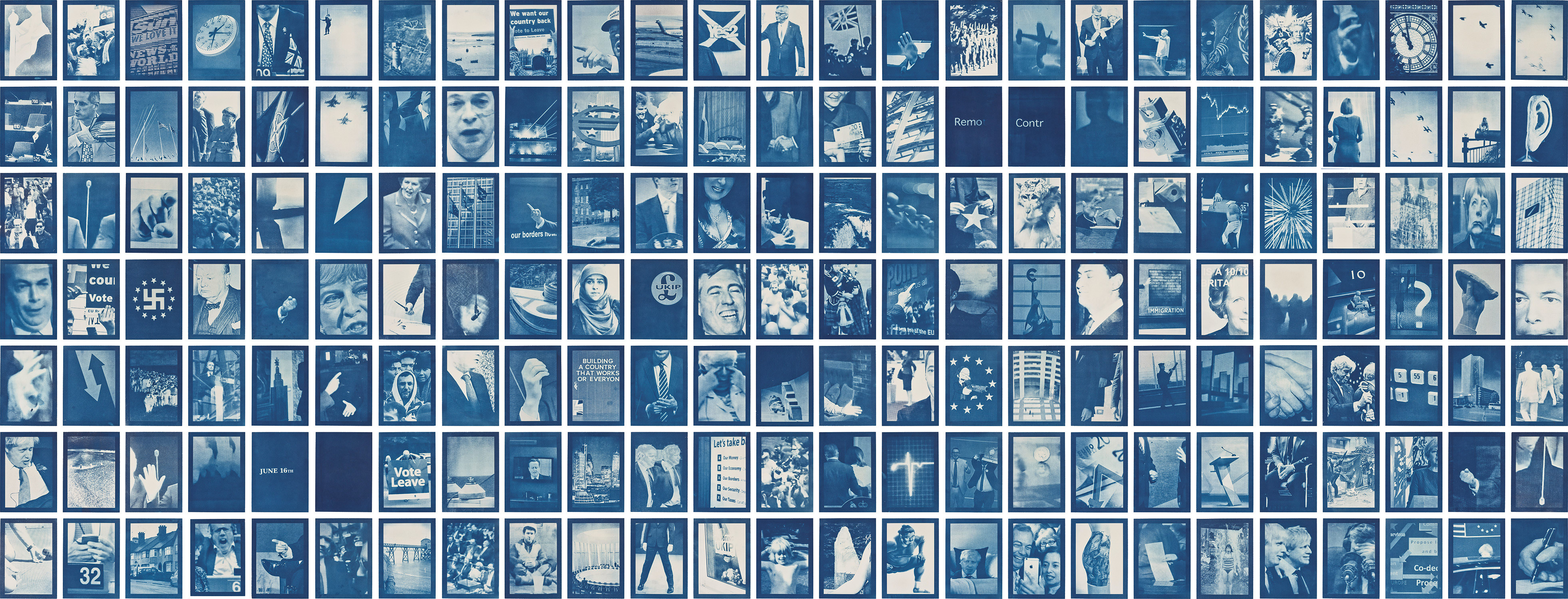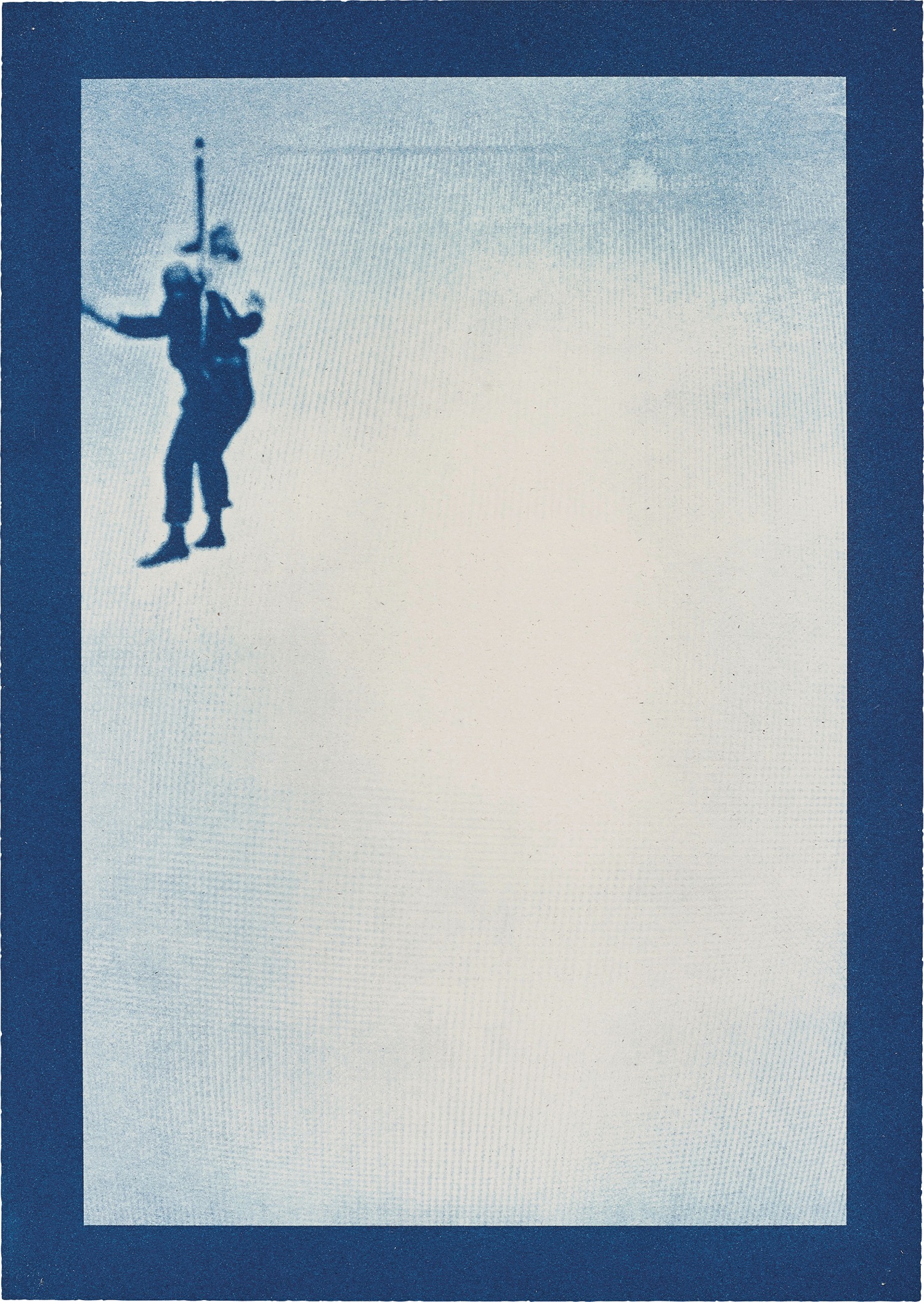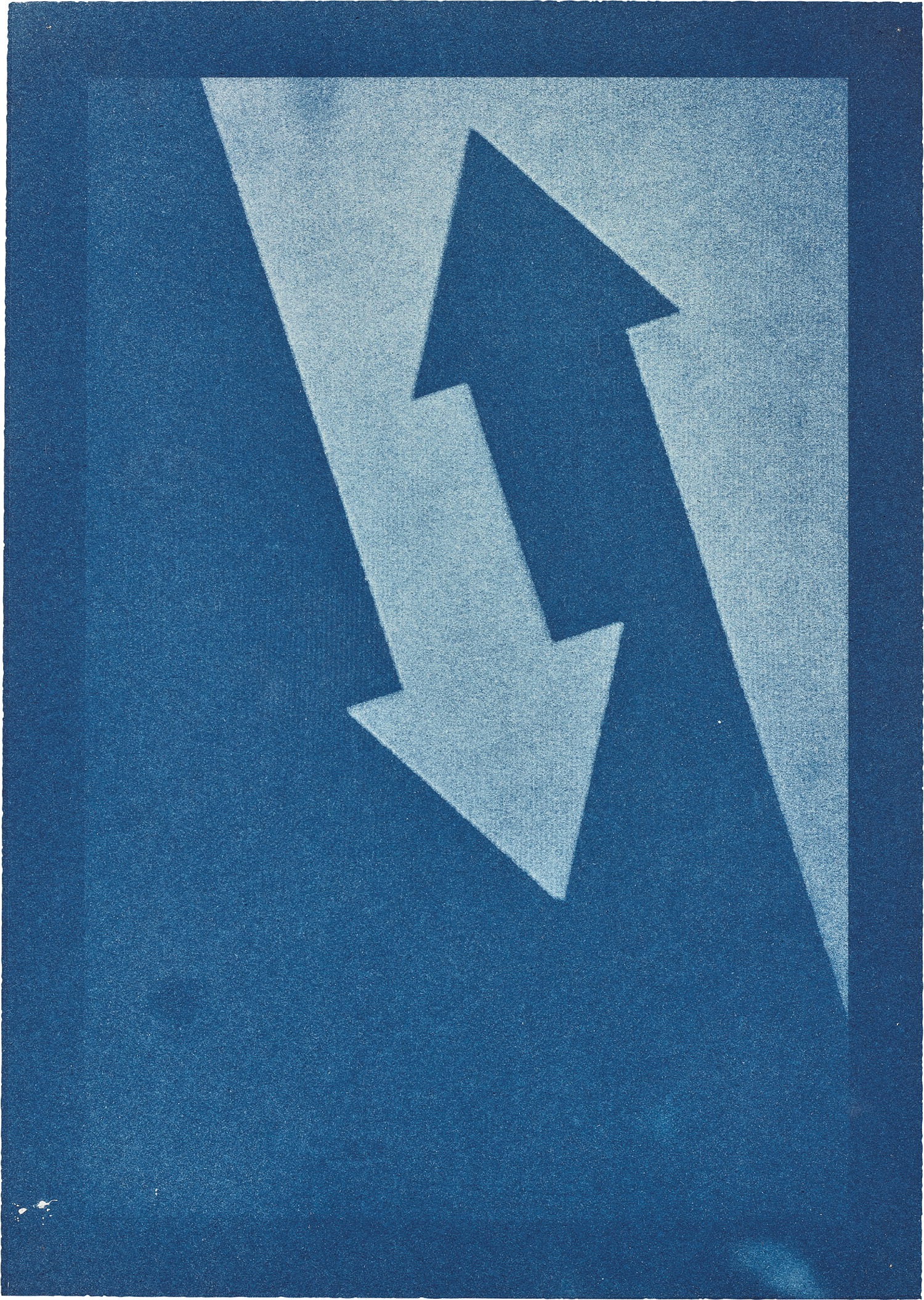











ULTIMATE
19
Norman Behrendt
Blueprint
2017-2018
Unique polyptych, comprising 175 cyanotypes
Each image: 37 x 24.5 cm (14 5/8 x 9 5/8 in.)
Each sheet: 42 x 29.7 cm (16 1/2 x 11 3/4 in.)
Overall: 312 x 814.5 cm (122 7/8 x 320 5/8 in.)
Each sheet: 42 x 29.7 cm (16 1/2 x 11 3/4 in.)
Overall: 312 x 814.5 cm (122 7/8 x 320 5/8 in.)
Each initialled and numbered sequentially in pencil on the verso; signed in ink, printed title and date on the accompanying Certificate of Authenticity. Contained within a grey clamshell case with printed credit, title and date.
This work is unique.
This work is unique.
Full-Cataloguing
‘Each photograph is the outcome of a process of dismantling the visual language of the media into its layers and thereby scrutinising and recycling these pixelated, transient images.’
Norman Behrendt
On 23 June 2016, in a historic referendum, a small majority of UK citizens voted for Britain's 'exit' from the European Union, a process commonly known as Brexit. Arriving in London in August 2017, Norman Behrendt observed how news channels, newspapers and social media were filled with accusations, historical allusions and propaganda around the many unresolved issues concerning economic consequences, sovereignty, immigration, borders and the political costs of this historic decision. He started to explore the ways in which different media outlets visualise the issues surrounding Brexit, examining how it is presented on both sides of the argument. Focusing on videos found on social media sites and YouTube, Behrendt would screenshot stills from moving images then create abstract crops out of the original image. He explains his image-making process: ‘Each photograph is the outcome of a process of dismantling the visual language of the media into its layers and thereby scrutinising and recycling these pixelated, transient images’. From 3,760 images, he elected 175 that question how the visual language of mass media around Brexit has manipulated and spread popular beliefs concerning national pride and social anxiety.
When it came to printing his 175 images, Behrendt decided on the cyanotype process after reading an article that asked, ‘Do Eurosceptic parties and political movements within other EU states plan to use Brexit as blueprint to quit EU?’ The cyanotype, an early photographic process discovered by English scientist-astronomer John Herschel in 1842, was used mainly as a means of reproducing drawings and diagrams, as in blueprints. In the polyptych Blueprint, 2017-18, this historical photographic method traces the practices of present day media and mirrors them back in striking cyan blue. The laborious process involved creating 175 negative transparencies, hand-coating lining papers then contact printing them in an ultraviolet light exposure unit. The resulting cyanotypes are impressively even in tone. For Behrendt, the bright Prussian blue reflects both the European Union and its invisible influence on the United Kingdom, and the color of conservatism and the Tories. Displayed on the wall, the entire project measures 312 x 815 cm; Blueprint is accompanied by a custom designed clamshell box, which neatly contains all 175 prints.
‘The individual images are chosen for their iconography and graphic punch — they are visual metaphors that persuade, lie, convince, scare and at the same time seduce us,’ art historian Lucy Soutter explains, 'together they contribute to a layered message about the roles of history and the ideologies that shape British attitudes about Brexit, drawing our attention to gestures of power and symbols of nationhood. The grid itself creates a visual text whose juxtapositions can be read in many directions – a fragmented mosaic of reality that provokes a feeling of disorientation and uncertainty.' Back in his native Germany, Behrendt is currently focusing on examining the German media’s perspective.
Behrendt’s work deals with the political and social changes of our time, existing between documentary and conceptual photography. His photobook burning down the house (2014) was awarded the First Prize at the 2013 Kassel Dummy Award and received special acknowledgement at Gera’s 2013 Aenne Biermann Prize for contemporary German photography. His ongoing series Brave New Turkey was nominated for the Discovery Award at the Rencontres d’Arles in 2017 and also published in the 18 June 2017 issue of the New York Times Magazine.
Norman Behrendt
On 23 June 2016, in a historic referendum, a small majority of UK citizens voted for Britain's 'exit' from the European Union, a process commonly known as Brexit. Arriving in London in August 2017, Norman Behrendt observed how news channels, newspapers and social media were filled with accusations, historical allusions and propaganda around the many unresolved issues concerning economic consequences, sovereignty, immigration, borders and the political costs of this historic decision. He started to explore the ways in which different media outlets visualise the issues surrounding Brexit, examining how it is presented on both sides of the argument. Focusing on videos found on social media sites and YouTube, Behrendt would screenshot stills from moving images then create abstract crops out of the original image. He explains his image-making process: ‘Each photograph is the outcome of a process of dismantling the visual language of the media into its layers and thereby scrutinising and recycling these pixelated, transient images’. From 3,760 images, he elected 175 that question how the visual language of mass media around Brexit has manipulated and spread popular beliefs concerning national pride and social anxiety.
When it came to printing his 175 images, Behrendt decided on the cyanotype process after reading an article that asked, ‘Do Eurosceptic parties and political movements within other EU states plan to use Brexit as blueprint to quit EU?’ The cyanotype, an early photographic process discovered by English scientist-astronomer John Herschel in 1842, was used mainly as a means of reproducing drawings and diagrams, as in blueprints. In the polyptych Blueprint, 2017-18, this historical photographic method traces the practices of present day media and mirrors them back in striking cyan blue. The laborious process involved creating 175 negative transparencies, hand-coating lining papers then contact printing them in an ultraviolet light exposure unit. The resulting cyanotypes are impressively even in tone. For Behrendt, the bright Prussian blue reflects both the European Union and its invisible influence on the United Kingdom, and the color of conservatism and the Tories. Displayed on the wall, the entire project measures 312 x 815 cm; Blueprint is accompanied by a custom designed clamshell box, which neatly contains all 175 prints.
‘The individual images are chosen for their iconography and graphic punch — they are visual metaphors that persuade, lie, convince, scare and at the same time seduce us,’ art historian Lucy Soutter explains, 'together they contribute to a layered message about the roles of history and the ideologies that shape British attitudes about Brexit, drawing our attention to gestures of power and symbols of nationhood. The grid itself creates a visual text whose juxtapositions can be read in many directions – a fragmented mosaic of reality that provokes a feeling of disorientation and uncertainty.' Back in his native Germany, Behrendt is currently focusing on examining the German media’s perspective.
Behrendt’s work deals with the political and social changes of our time, existing between documentary and conceptual photography. His photobook burning down the house (2014) was awarded the First Prize at the 2013 Kassel Dummy Award and received special acknowledgement at Gera’s 2013 Aenne Biermann Prize for contemporary German photography. His ongoing series Brave New Turkey was nominated for the Discovery Award at the Rencontres d’Arles in 2017 and also published in the 18 June 2017 issue of the New York Times Magazine.